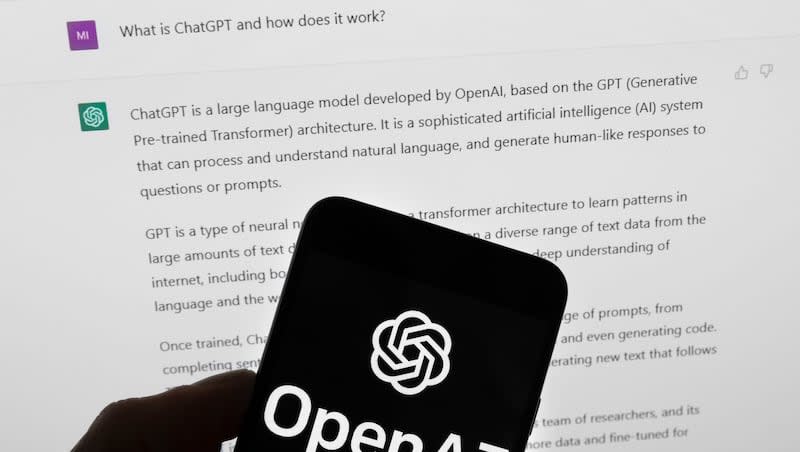What’s the right way to use AI in classrooms?

The AI research and development company OpenAI recently announced the newest model of its AI program: ChatGPT-4o.
“GPT-4o (‘o’ for ‘omni’) is a step towards much more natural human-computer interaction,” OpenAI said on its website.
AI models like ChatGPT work by receiving a prompt from a user and generating a response from its vast collection of internet data. More advanced models can respond to increasingly complex prompts.
Alongside the model’s introduction, OpenAI released several demonstration videos showcasing GPT-4o’s capabilities.
The videos highlighted the AI’s potential in various scenarios, including human-like conversations, interactions between two AIs, real-time translation, interview preparation and even a customer service proof of concept.
Perhaps one of the most notable features was GPT-4o’s ability to function as an educational tool.
How will AI change education?
The use of AI in education has been a contentious topic. Critics argue that AI may facilitate cheating and undermine students’ learning abilities, which has led to it being banned in some schools.
The New York Times, however, reported in December on research that claimed these concerns were overblown. The researchers concluded that cheating in schools has not risen with AI development.
“In surveys this year of more than 40 U.S. high schools, some 60 to 70 percent of students said they had recently engaged in cheating — about the same percent as in previous years,” The New York Times reported.
GPT-4o, which is free to use, adds more complexity to this debate, but it also offers promising possibilities.
OpenAI’s demonstration of GPT-4o’s educational capabilities emphasizes the potential this technology has to assist individuals in learning through personalized teaching.
The demo shows a father and son using GPT-4o to tackle a challenging problem. The father, who is Sal Kahn of the Khan Academy, instructs the AI not to provide the answer but to guide his son towards discovering it himself.
By sharing a tablet screen, GPT-4o engages the child with questions, encouraging him through mistakes until he arrives at the correct solution.
According to Inside Higher Ed, AI can assist in various educational tasks, including administering assessments, providing personalized tutoring, generating educational materials and analyzing data.
These capabilities suggest a transformative potential for AI in education, fostering personalized and adaptive learning experiences.
Will AI be used in schools?
As AI technology evolves, educators are exploring how to integrate it into classrooms effectively. Some schools have already adopted an approach known as “blended learning,” a hybrid of online and traditional education methods.
Earlier this month, USA Today reported that Pease Elementary School, under Principal Micah Arrott, has embraced AI, transforming their classroom dynamics and enhancing student engagement.
“AI and adaptive software have completely changed how our classrooms look, our school climate, and culture. The student engagement is absolutely magnificent,” Arrott told USA Today.
Even schools that have banned AI tools like ChatGPT recognize the potential benefits of future AI advancements.
As previously reported by the Deseret News, Jordan School District, under Superintendent Anthony Godfrey, originally blocked access to ChatGPT, but has since made SchoolAI, an AI-based learning platform, available across its 67 schools.
SchoolAI aims to support teachers by providing curated content tailored to each student’s needs.
Caleb Hicks, founder of SchoolAI, told the Deseret News, “While many school districts have banned ChatGPT, we’ve found they’re eager to adopt SchoolAI in their classrooms once they see an AI-driven interface that enables teachers and students to connect with daily check-ins, tailored tutoring, simulations, and games that adapt to every student’s interests and skill level.”
Will AI replace teachers?
The rise of AI in education raises concerns about whether it could replace teachers.
This anxiety extends beyond education, as some fear that AI could take jobs in programming, the arts and other fields. The 2023 writers strike highlighted these concerns with one of their major areas of contention being over how to protect their jobs from AI, per The Associated Press.
However, educators and AI developers stress that current AI models cannot replace teachers and are, instead, a tool that can be used to enhance their effectiveness. For example, SchoolAI aims to help students stay engaged and productive in moments when their teacher isn’t available, as the Deseret News previously reported.
Hicks said that SchoolAI aims to facilitate better connections between students and teachers, not replace teachers.
Godfrey said, “Teachers can never be replaced. The relationship between teachers and students is essential. SchoolAI enhances that as an effective teacher’s aid and student tutor.”
While others believe that AI models will be more central to education one day than traditional teachers, most would simply say that the future is uncertain. Schools will continue to adjust their approach to AI models, as companies like OpenAI continue to adjust the models themselves.

